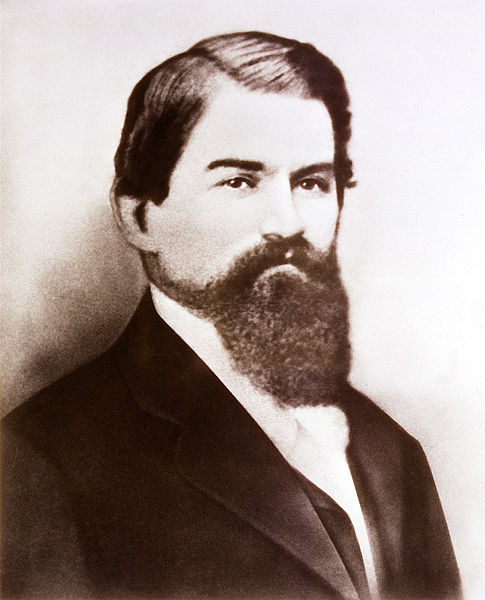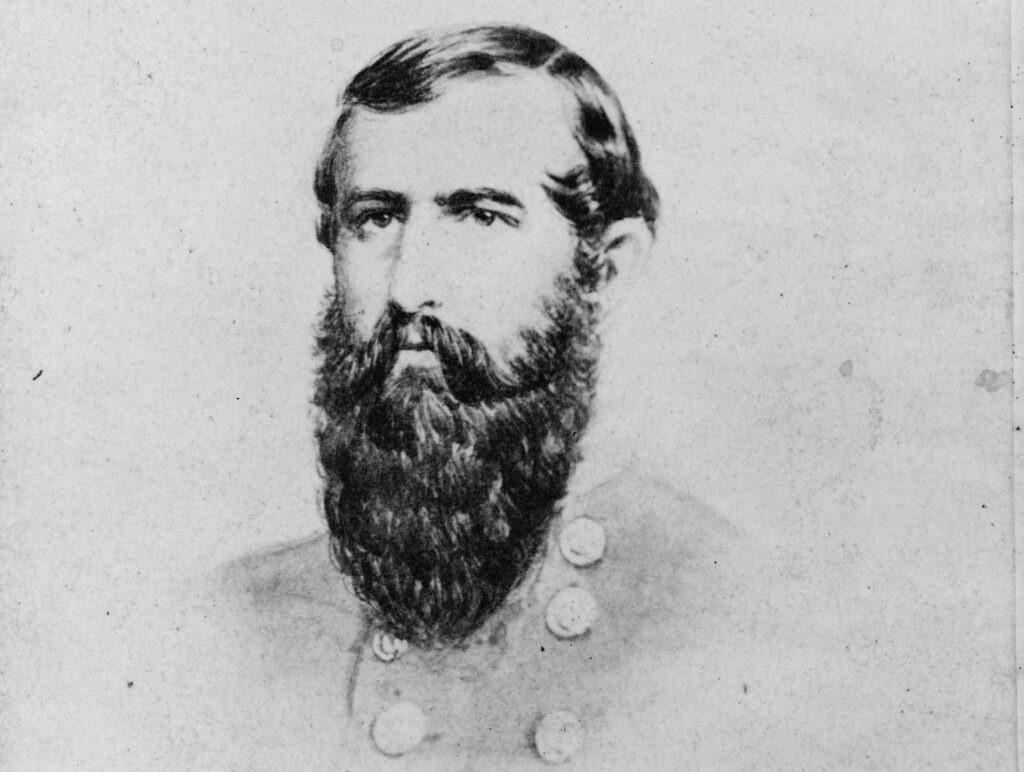Dark, caramel-brown, and bubbly, Coca-Cola is one of the most recognizable brands in the world. Over the decades of its existence, Coca-Cola has gone from a simple medicinal fountain drink to a worldwide phenomenon. Everyone, everywhere, knows Coca-Cola.
But even the greatest innovations have to start somewhere, and more often than not, those beginnings can be humble. This is especially true for the inventor of Coca-Cola, John Pemberton, who was simply looking for relief for his pain and instead stumbled upon a recipe that would endure long after his death.
John Pemberton, a veteran and entrepreneur, might not have owned the rights to Coca-Cola for very long, but even in that short time, he knew what he had on his hands was extraordinary. Pemberton’s transformation from pharmacist to creator of a global phenomenon is fascinating.

The Early Life of John Pemberton
Born on July 8th, 1831, in Knoxville Georgia, John Pemberton was the son of James C. Pemberton and Martha L. Grant. Most of his early childhood was spent in Rome, Georgia, and his family was comfortably middle class.
From a young age, Pemberton was said to have a keen intellect and an aptitude for both science and medicine even in his youth. He would continue down this path as he aged, attending the Reform Medical College of Georgia in the town of Macon.
In college, he studied pharmacology, cementing his interest in medicine that would pop back up again in his later life when he began experimenting with cola prototypes. John Pemberton was only 19 when he earned his medical degree, displaying an exceptional talent in chemistry by the time he graduated.
At first, Pemberton tried his hand at practicing medicine, and even performing a few surgeries, before he decided that his interest was still in chemistry and pharmacology above everything else. With that realization, Pemberton opened a drugstore in Columbus, Georgia.
John would meet his wife, Ann Eliza Clifford Lewis in Macon, and the two were married in 1853. The two would have one child together, Charles Nay Pemberton, only one year later, in 1854.
The couple lived in a Victorian cottage in Columbus that held up well enough throughout the years that it was added to the National Registry of Historic Places.
John Pemberton’s Years in the Civil War
The peaceful life that Pemberton had built for himself and his family was soon disturbed by the American Civil War breaking out all around him. In 1861, he enlisted as a Confederate soldier, leaving his family and pharmacy behind.
It’s believed that Pemberton worked as a medic in the army, but that didn’t keep him away from battle. It was April 1865 when Pemberton, at the Battle of Columbus, was injured in battle. The wound was grievous–a saber wound to his chest–and the pain of it was nearly unbearable.
In order to deal with his war wound, Pemberton started to take morphine to try and combat the pain. The more he used it, the less it worked for him, and Pemberton started to get desperate to find some relief.
With his penchant for chemistry, Pemberton thought that he might be the one who was able to ease his own suffering. One year later, deep in his addiction, Pemberton knew he had to seek out a cure for his addiction. This is what led him down the path of creating his own tonic drinks.
The Creation of Coca-Cola
By 1866, John Pemberton was desperate for another painkiller to help break his morphine addiction. He started to experiment with new options, some of them safer than others.
The first product that Pemberton managed to create was a sort of syrup with the active ingredient buttonbush or Cephalanthus occidentalis. In reality, buttonbush is a toxic plant, but he still managed to produce enough of it to give it a name, “Dr. Tuggles Compound Syrup of Globe Flower”.
It did not go over very well. There are no reports of Dr. Tuggle’s Syrup causing any issues, but it clearly didn’t solve Pemberton’s pain problem, since he continued to experiment after this first concoction.

Pemberton’s next foray into tonics had him experimenting with coca and coca wines. As the name suggests, the coca plant is the plant from which cocaine is derived. Coca wine, on the other hand, is a mixture of wine and cocaine. Both the coca plant in its raw form and coca wine can cause inebriation of sorts, so these mixtures did help with pain more than the previous buttonbush tonics.
Combining coca, kola nuts, and a native southeastern plant called damiana, Pemberton created the first iteration of what would eventually be Coca-Cola, naming this drink “Pemberton’s French Wine Coca”. He started producing this tonic in Columbus, but it swiftly made its way to Atlanta.
French Wine Coca
French wine coca in general was a popular drink used for medicinal issues. Invented in 1863 by Parisian chemist Angelo Mariani, the alcoholic beverage became wildly popular in a short amount of time. The main ingredient that made it so effective was cocaethylene, which is a potent mixture of alcohol and cocaine.
So popular was French coca wine that even celebrities at the time were said to enjoy it. This beverage was so ubiquitous that the Pope at the time, Pope Leo XIII, was known to partake.
The Invention of Coca-Cola
John Pemberton had noticed how successful coca wine was in Europe, and he hoped that his version would find equal success stateside. At that point it wasn’t just about fighting his own addiction–it was about commercial success, too.
Pemberton had landed on something special, and just as he had hoped, the star of his Pemberton’s French Wine Coca was on the rise. It was known by name in many households, so much so that the product was even mentioned in Ulysses S. Grant’s writings, where he was said to drink the coca wine for a painful sore throat brought on by cancer.
This wine coca gave its drinkers a sort of energy, leaving them feeling invigorated and fighting pain for at least a short time. Pemberton himself pushed the drink as a cure-all, suggesting that it could fix any ailment and that it was especially useful for women.
His success was halted momentarily in 1885 when Atlanta and Fulton County in Georgia put temperance legislation into place. This meant that nothing alcoholic could be sold, and that included the supposedly medicinal Pemberton’s French Wine Coca.
Not to be discouraged, though, Pemberton rushed to create a version of his tonic that was alcohol-free. This is where the coca wine really started to change into something resembling the Coca-Cola we know and love.
Pemberton tweaked his recipe, mixing the syrupy component of it with carbonated water to turn it into something easy to drink and that was refreshing to the palate. He brought his new version of his tonic to Atlanta drugstore owner Willis E. Venerable, who loved it. It was decided that this new coca drink would be served as a fountain drink, and not in a bottle purchased from the pharmacy like it was previously.
Another man, marketer Fran Mason Robinson, suggested a new name for the product to Pemberton–Coca-Cola–since the drink contained both coca plant and kola nuts. The alliteration made the name memorable, so much so that it’s known nearly around the globe today.
Pemberton’s Life After Coca-Cola
In the beginning of John Pemberton’s foray into beverage making, his goal had been to find a way to elude his crippling morphine addiction. The pain from his saber wound had never truly faded, and right alongside it, the morphine addiction had remained.
Coca-Cola was a smash hit, even when the coca part of the recipe had to be removed early in the 20th century. Popularity, though, wasn’t helping John to feel any better.
Not too long after Coca-Cola burst onto the soda scene, Pemberton became ill and nearly went bankrupt. In his illness, with almost no money left to his name, there was only one thing to do–sell Coca-Cola.
He didn’t sell his entire business to one person, though. Slowly, Pemberton started to portion out the Coca-Cola business to his various partners and associates. With death lingering on the horizon for John Pemberton, he sold the remainder of his company to fellow Atlanta businessman Asa G. Candler, who worked to gain all the company shares as soon as possible.
On August 16th, 1888, John Pemberton passed away, having sold Coca-Cola for $1,750. In the end, it was stomach cancer that ended Pemberton’s life, but his legacy lives on.
Despite selling Coca-Cola for so little, Pemberton was noted as saying that he thought Coca-Cola would “someday be a national drink”, and he couldn’t have been more correct. Hundreds of years later, consumers drink 2.2 billion servings of Coca-Cola every day–a far cry from the nine servings a day that Pemberton sold during his first year selling Coca-Cola.
References
“The Birth of a Refreshing Idea”
https://www.coca-colacompany.com/about-us/history/the-birth-of-a-refreshing-idea
“John Pemberton”

